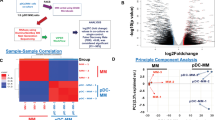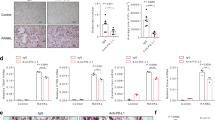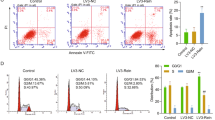Abstract
Novel therapies for multiple myeloma (MM) can target mechanism(s) in the host-MM bone marrow (BM) microenvironment mediating MM progression and chemoresistance. Our studies showed increased numbers of tumor-promoting, immunosuppressive and drug-resistant plasmacytoid dendritic cells (pDCs) in the MM BM microenvironment. pDC-MM cell interactions upregulate interleukin-3 (IL-3), which stimulates both pDC survival and MM cell growth. Since IL-3 R is highly expressed on pDCs in the MM BM milieu, we here targeted pDCs using a novel IL-3 R-targeted therapeutic SL-401. In both in vitro and in vivo models of MM in its BM milieu, SL-401 decreases viability of pDCs, blocks pDC-induced MM cell growth, and synergistically enhances anti-MM activity of bortezomib and pomalidomide. Besides promoting pDC survival and MM cell growth, IL-3 also mediates progression of osteolytic bone disease in MM. Osteoclast (OCL) progenitor cells express IL-3 R, and we show that SL-401 abrogates monocyte-derived OCL formation and bone resorption. Finally, we show that SL-401 also decreases the viability of IL-3 R-expressing cancer stem-like cells in MM. Overall, our study provides the preclinical basis for clinical trials of SL-401 to block pDC-induced MM cell growth, inhibit osteoclastogenesis and target MM stem-like cell subpopulations to improve patient outcome in MM.
This is a preview of subscription content, access via your institution
Access options
Subscribe to this journal
Receive 12 print issues and online access
$259.00 per year
only $21.58 per issue
Buy this article
- Purchase on Springer Link
- Instant access to full article PDF
Prices may be subject to local taxes which are calculated during checkout






Similar content being viewed by others
References
Anderson KC . The 39th David A. Karnofsky Lecture: bench-to-bedside translation of targeted therapies in multiple myeloma. J Clin Oncol 2012; 30: 445–452.
Anderson KC . Multiple myeloma. Hematol Oncol Clin North Am 2014; 28: xi–xii.
Tai YT, Acharya C, An G, Moschetta M, Zhong MY, Feng X et al. APRIL and BCMA promote human multiple myeloma growth and immunosuppression in the bone marrow microenvironment. Blood 2016; 127: 3225–3236.
An G, Acharya C, Feng X, Wen K, Zhong M, Zhang L et al. Osteoclasts promote immune suppressive microenvironment in multiple myeloma: therapeutic implication. Blood 2016; 128: 1590–1603.
Chauhan D, Singh AV, Brahmandam M, Carrasco R, Bandi M, Hideshima T et al. Functional interaction of plasmacytoid dendritic cells with multiple myeloma cells: a therapeutic target. Cancer Cell 2009; 16: 309–323.
Ray A, Das DS, Song Y, Richardson P, Munshi NC, Chauhan D et al. Targeting PD1-PDL1 immune checkpoint in plasmacytoid dendritic cell interactions with T cells, natural killer cells and multiple myeloma cells. Leukemia 2015; 29: 1441–1444.
Brown RD, Pope B, Murray A, Esdale W, Sze DM, Gibson J et al. Dendritic cells from patients with myeloma are numerically normal but functionally defective as they fail to up-regulate CD80 (B7-1) expression after huCD40LT stimulation because of inhibition by transforming growth factor-beta1 and interleukin-10. Blood 2001; 98: 2992–2998.
Ratta M, Fagnoni F, Curti A, Vescovini R, Sansoni P, Oliviero B et al. Dendritic cells are functionally defective in multiple myeloma: the role of interleukin-6. Blood 2002; 100: 230–237.
Grouard G, Rissoan MC, Filgueira L, Durand I, Banchereau J, Liu YJ . The enigmatic plasmacytoid T cells develop into dendritic cells with interleukin (IL)-3 and CD40-ligand. J Exp Med 1997; 185: 1101–1111.
Lee JW, Chung HY, Ehrlich LA, Jelinek DF, Callander NS, Roodman GD et al. IL-3 expression by myeloma cells increases both osteoclast formation and growth of myeloma cells. Blood 2004; 103: 2308–2315.
Liu Y, Xia D, Li F, Zheng C, Xiang J . Intratumoral administration of immature dendritic cells following the adenovirus vector encoding CD40 ligand elicits significant regression of established myeloma. Cancer Gene Ther 2005; 12: 122–132.
Reizis B, Bunin A, Ghosh HS, Lewis KL, Sisirak V . Plasmacytoid dendritic cells: recent progress and open questions. Annu Rev Immunol 2011; 29: 163–183.
Angelot-Delettre F, Roggy A, Frankel AE, Lamarthee B, Seilles E, Biichle S et al. in vivo and in vitro sensitivity of blastic plasmacytoid dendritic cell neoplasm to SL-401, an interleukin-3 receptor targeted biologic agent. Haematologica 2015; 100: 223–230.
Frankel AE, Woo JH, Ahn C, Pemmaraju N, Medeiros BC, Carraway HE et al. Activity of SL-401, a targeted therapy directed to interleukin-3 receptor, in blastic plasmacytoid dendritic cell neoplasm patients. Blood 2014; 124: 385–392.
Frankel AE, Konopleva M, Hogge D, Rizzieri D, Brooks C, Cirrito T et al. Activity and tolerability of SL-401, a targeted therapy directed to the interleukin-3 receptor on cancer stem cells and tumor bulk, as a single agent in patients with advanced hematologic malignancies. J Clin Oncol 2013; 31 (15 Suppl): 7029.
Pemmaraju N, Lane AA, Sweet KL, Stein AS, Vasu S, Blum WG et al. Results from phase 2 registration trial of SL-401 in patients with blastic plasmacytoid dendritic cell neoplasm (BPDCN): Lead-in completed, expansion stage ongoing.2016 ASCO Annual Meeting. J Clin Oncol 2016; 34(suppl): abstr 7006.
Lane AA, Sweet KL, Wang ES, Donnellan WB, Walter RB, Stein AS et al. Results from ongoing phase 2 trial of SL-401 as consolidation therapy in patients with acute myeloid leukemia (AML) in remission with high relapse risk including minimal residual disease (MRD). ASH, 2016. Blood 2016; 128: 215.
Mani R, Goswami S, Gopalakrishnan B, Ramaswamy R, Wasmuth R, Tran M et al. SL-401 mediates potent cytotoxicity against CD123+ AML and MDS with excess blasts and demonstrates therapeutic benefit in PDX model. Blood 2016; 128: 580.
Gionco J, Chen J, Lindsay R, Macri V, Brooks CL . SL-401, a targeted therapy directed to the interleukin-3 receptor (CD123), and SL-801, a reversible inhibitor of exportin-1 (XPO1), display synergistic anti-tumor activity against hematologic malignancies in vitro. Blood 2016; 128: 4724.
Pemmaraju N, Lane AA, Sweet KL, Stein AS, Vasu S, Blum W et al. Results from Phase 2 trial ongoing expansion stage of SL-401 in patients with blastic plasmacytoid dendritic cell neoplasm (BPDCN). 2016. Blood 2016; 128: 342.
Htut M, Gasparetto C, Zonder J, Martin TG III, Scott EC, Chen J et al. Results from ongoing phase 1/2 trial of SL-401 in combination with pomalidomide and dexamethasone in relapsed or refractory multiple myeloma. Blood 2016; 128: 5696.
Patnaik MM, Gupta V, Gotlib JR, Carraway HE, Wadleigh M, Schiller G et al. Results from ongoing phase 2 trial of SL-401 in patients with advanced, high-risk myeloproliferative neoplasms including chronic myelomonocytic leukemia. Blood 2016; 128: 4245.
Jakubikova J, Adamia S, Kost-Alimova M, Klippel S, Cervi D, Daley JF et al. Lenalidomide targets clonogenic side population in multiple myeloma: pathophysiologic and clinical implications. Blood 2011; 117: 4409–4419.
Chauhan D, Tian Z, Nicholson B, Kumar KG, Zhou B, Carrasco R et al. A small molecule inhibitor of ubiquitin-specific protease-7 induces apoptosis in multiple myeloma cells and overcomes bortezomib resistance. Cancer Cell 2012; 22: 345–358.
Ray A, Tian Z, Das DS, Coffman RL, Richardson P, Chauhan D et al. A novel TLR-9 agonist C792 inhibits plasmacytoid dendritic cell-induced myeloma cell growth and enhance cytotoxicity of bortezomib. Leukemia 2014; 28: 1716–1724.
Gerrard L, Zhao D, Clark AJ, Cui W . Stably transfected human embryonic stem cell clones express OCT4-specific green fluorescent protein and maintain self-renewal and pluripotency. Stem Cells 2005; 23: 124–133.
Tassone P, Neri P, Carrasco DR, Burger R, Goldmacher VS, Fram R et al. A clinically relevant SCID-hu in vivo model of human multiple myeloma. Blood 2005; 106: 713–716.
Richardson PG, Siegel D, Baz R, Kelley SL, Munshi NC, Laubach J et al. Phase 1 study of pomalidomide MTD, safety, and efficacy in patients with refractory multiple myeloma who have received lenalidomide and bortezomib. Blood 2013; 121: 1961–1967.
Maeda T, Murata K, Fukushima T, Sugahara K, Tsuruda K, Anami M et al. A novel plasmacytoid dendritic cell line, CAL-1, established from a patient with blastic natural killer cell lymphoma. Int J Hematol 2005; 81: 148–154.
Silbermann R, Bolzoni M, Storti P, Guasco D, Bonomini S, Zhou D et al. Bone marrow monocyte-/macrophage-derived activin A mediates the osteoclastogenic effect of IL-3 in multiple myeloma. Leukemia 2014; 28: 951–954.
Ehrlich LA, Chung HY, Ghobrial I, Choi SJ, Morandi F, Colla S et al. IL-3 is a potential inhibitor of osteoblast differentiation in multiple myeloma. Blood 2005; 106: 1407–1414.
Tai YT, Chang BY, Kong SY, Fulciniti M, Yang G, Calle Y et al. Bruton tyrosine kinase inhibition is a novel therapeutic strategy targeting tumor in the bone marrow microenvironment in multiple myeloma. Blood 2012; 120: 1877–1887.
Matsui W, Huff CA, Wang Q, Malehorn MT, Barber J, Tanhehco Y et al. Characterization of clonogenic multiple myeloma cells. Blood 2004; 103: 2332–2336.
Han L, Rowinsky E, Brooks C, Zal T, Zal MA, Burks JK et al. Anti-leukemia efficacy and mechanisms of action of SL-101, a novel anti-CD123 antibody-conjugate in acute myeloid leukemia. Blood 2014; 124: 981.
Lasho T, Finke C, Kimlinger TK, Zblewski D, Chen D, Patnaik MM et al. Expression of CD123 (IL-3 R-alpha), a therapeutic target of SL-401, on myeloproliferative neoplasms. Blood 2014; 124: 5577.
Brooks CR, van Dalen CJ, Hermans IF, Douwes J . Identifying leukocyte populations in fresh and cryopreserved sputum using flow cytometry. Cytometry B Clin Cytom 2013; 84: 104–113.
Hogge DE, Feuring-Buske M, Gerhard B, Frankel AE . The efficacy of diphtheria-growth factor fusion proteins is enhanced by co-administration of cytosine arabinoside in an immunodeficient mouse model of human acute myeloid leukemia. Leuk Res 2004; 28: 1221–1226.
Konopleva M, Hogge DE, Rizzieri DA, Cirrito TP, Kornblau SM, Borthakur G et al. SL-401, a targeted therapy directed to the interleukin-3 receptor present on leukemia blasts and cancer stem cells, is active as a single agent in patients with advanced AML. Blood 2012; 120: 3625.
Pinnamaneni P, Jorgensen JL, Kantarjian HM, Jabbour E, Pierce SR, Brandt M et al. Persistence of minimal residual disease assessed by multi-parameter flow cytometry (MFC) at 30 and 90 days after achieving complete remission predicts outcome in patients with acute myeloid leukemia. Blood 2014; 124: 1015.
Frolova O, Benito J, Brooks C, Wang RY, Korchin B, Rowinsky EK et al. SL-401 and SL-501, targeted therapeutics directed at the interleukin-3 receptor, inhibit the growth of leukaemic cells and stem cells in advanced phase chronic myeloid leukemia. Br J Haematol 2014; 166: 862–874.
Acknowledgements
The grant support for this investigation was provided by National Institutes of Health Specialized Programs of Research Excellence (SPORE) grant P50100707, R01CA207237, and RO1 CA050947. KCA is an American Cancer Society Clinical Research Professor.
Author contributions
DC designed the research, analyzed the data and wrote the manuscript; AR performed the experiments and analyzed the data; CLB and VM provided SL-401 and reviewed the manuscript; DSD helped in in vivo SCID-hu mouse study and flow cytometry; YS helped in generation of Oct4 cells and flow cytometry; PR provided clinical samples; and KCA analyzed the data and wrote the manuscript.
Author information
Authors and Affiliations
Corresponding authors
Ethics declarations
Competing interests
KCA is on Advisory board of Celgene, Millenium, Gilead and Bristol Myers Squibb, and is a Scientific Founder of Acetylon, Oncopep, and C4 Therapeutics. DC is consultant to Stemline Therapeutic, Inc. The remaining authors declare no conflict of interest.
Additional information
Supplementary Information accompanies this paper on the Leukemia website
Supplementary information
Rights and permissions
About this article
Cite this article
Ray, A., Das, D., Song, Y. et al. A novel agent SL-401 induces anti-myeloma activity by targeting plasmacytoid dendritic cells, osteoclastogenesis and cancer stem-like cells. Leukemia 31, 2652–2660 (2017). https://doi.org/10.1038/leu.2017.135
Received:
Revised:
Accepted:
Published:
Issue Date:
DOI: https://doi.org/10.1038/leu.2017.135
This article is cited by
-
Identification and validation of ecto-5' nucleotidase as an immunotherapeutic target in multiple myeloma
Blood Cancer Journal (2022)
-
Targeting tryptophan catabolic kynurenine pathway enhances antitumor immunity and cytotoxicity in multiple myeloma
Leukemia (2020)
-
Blockade of ubiquitin receptor Rpn13 in plasmacytoid dendritic cells triggers anti-myeloma immunity
Blood Cancer Journal (2019)
-
Tagraxofusp: First Global Approval
Drugs (2019)
-
Biology and prognostic impact of clonal plasmacytoid dendritic cells in chronic myelomonocytic leukemia
Leukemia (2019)



